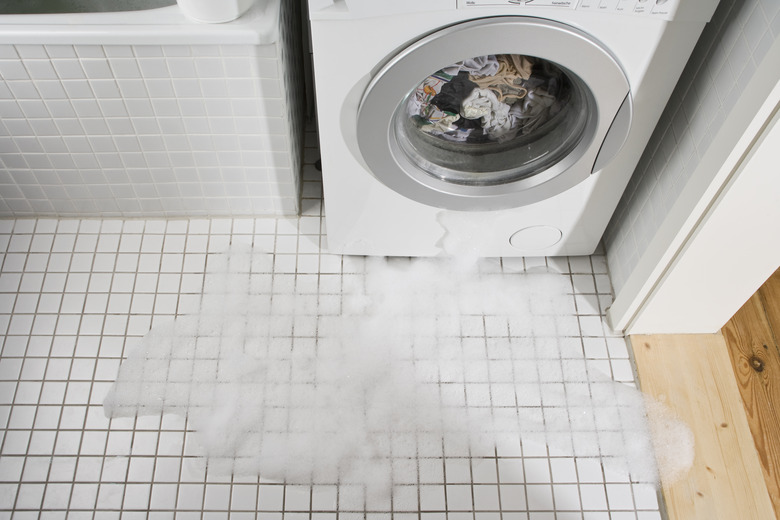How To Troubleshoot A Washing Machine Leak
There's something wrong with your washing machine if it's spewing water all over the floor, but don't panic. Repairing washing machine leaks may seem like a daunting proposition, yet it's actually quite easy – at least in most cases. Before you can make the repair, you have to know which part of the washing machine is leaking. A simple strategy can help, assuming the source of the leak isn't already obvious. Turn on the machine and watch whether it leaks during the fill stage, while the washing machine is agitating or when water is draining. This will narrow down the leak to a specific part of the machine. Once you know which part, you can decide whether or not you're up to the repair or you need an appliance pro.
Washing Machine Leaks During the Fill Cycle
Water enters the washing tub through the washer inlet valve, which is connected to the water supply through a pair of hoses. The hoses can wear out and leak. If that's what has happened, your job is easy. Simply replace the hoses, which are available at any hardware store. You may need a wrench to unscrew them from the water valves and washing machine, but they have standard garden hose connections so that shouldn't be difficult. The water inlet valve may also be leaking, and if so, you'll probably have to replace it. That involves removing the hoses from it, unscrewing it and reversing the procedure to install the new water inlet valve.
If the water seems to be coming from inside the machine, you'll have to remove the cover to find the source of the washing machine leak. It's probably a cracked hose or a bad hose connection. Replace the leaking hose, using pliers or a screwdriver to remove the clamp holding it and to affix the clamp to the new hose.
Drips and Splashes During the Washing Cycle
If the washing machine has a worn fitting around the tub or the agitator post, soapy water will drip or spill out when the agitator is working. You can sometimes replace a worn tub gasket yourself by following instructions in your owner's manual, but replacing the post gasket is difficult and should be referred to a pro. In addition, you might see evidence of leaking from one or more of the four seals that secure the outer tub to the cabinet. If you decide to do this repair yourself, it's advisable to replace all four using a kit you can get from the manufacturer.
If you have a front-loading washer and water is coming from the door, the door seal is usually at fault. Replace it with a new one.
Water Streaming or Dripping During the Drain Cycle
After the wash cycle is complete, a washer drain pump switches on and sends water into the drain hose connected to your home's waste system. This is when leaks most frequently occur, and it's usually because of something as simple as a worn hose or loose hose clamp. You may have to remove the cover to access the entire drainage system, but the washer drain pump is often accessible from the back of the machine or by just removing the front panel.
The best way to diagnose problems with the washer drain pump is to watch it while it's working, but be sure to unplug the machine before servicing it. If you see water coming from a hose or hose connection, replace that hose. If the water is coming from the pump, the part may be blocked. You may be able to remove the blockage, which could be a sock or some other small item, with a screwdriver. If the pump is cracked, you can replace it yourself. It's held on by three or four screws and gets power from a harness that is easy to unplug. Refer to the instructions in your owner's manual if you need more details about where it is and how to remove it.
